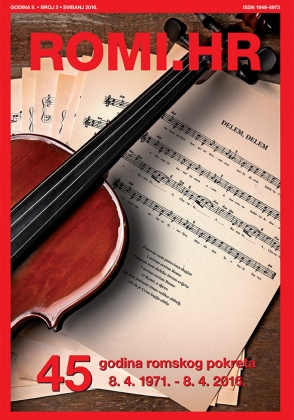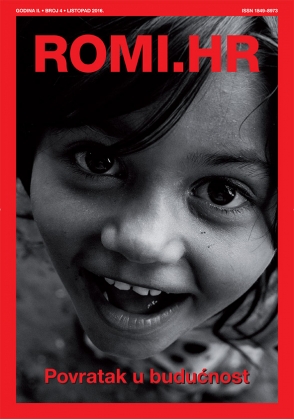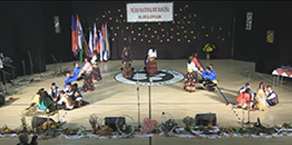Features ROMI.HR
/„Qaraca qız“ ("The Brunette"), written by Azerbaijani writer Suleyman Sani Akhundov, tells the story of Tutu, a little girl who was discriminated against because she belongs to Roman culture.
The early years of the Soviet rule were characterized by ruthless repression. Naturally, in Azerbaijan, not only individuals but also examples of art and creativity were subjected to repression due to their national and spiritual essence. The policy of creating Azerbaijani Soviet literature affected not only new works but also subjected classical works to ideological interventions or prohibitions. One of the works facing difficulties was the novel "Qaraca qız" ("The Brunette") written by Azerbaijani writer Suleyman Sani Akhundov, depicting the life of little girl Tutu, who grew up in the Roma group.
The Azerbaijani children's writer, playwright, and educator Akhundov wrote a series of stories under the title "Qorxulu nağıllar" ("Scary Tales") in the years 1912-1914. In these works, he depicted the struggles of Azerbaijani families, the difficult lives of children, and societal hardships. The work most subjected to changes among these works is the story "Qaraca qız," which has not been sufficiently researched and unexplored.
In the work "Qaraca qız," the author emphasizes that love and freedom do not depend on a person's identity, class and ethnic group. The writer presents these human qualities through the story of children who have not yet been poisoned by social labels. Unfortunately, the work underwent two alterations while passing through Soviet censorship, and they demanded the first change from the author himself. Dissatisfied with this, the educational department took matters into its own hands. Thus, the work, deviating from its main idea, turns towards instilling hatred for the nation's own history. It seems like a terrible fact that Akhundov, who is himself from a family of Bey`s, was forced to take such a position against his own nation. We can say that the work is influenced by the author's own memories and traumas. Suleiman, who studied at the Transcaucasian Teachers Seminary, was accused of embezzling the school's money, and his grades were reduced as punishment. At that time, the management's attitude towards the Azerbaijani seminarians was characterized by injustices and rudeness. Akhundov, who wrote suicide letters, shot himself in the heart with a gun, but fortunately survived.
The author used to write about the series: "These stories were indeed scary. But they did not scare the children; they revealed life truths to them, illuminated both the bright and dark sides of life, and reflected the spark of goodness and enmity." In the story, Tutu, an orphan, is first taken care of by the Roma group and then by Piri, the old gardener of the Bey’s family. The prologue extracted from the story contained the whole idea of the work. Here, it is emphasized that the story is told by Haji Samed to his son and daughter. Talking about the girl her friends bullied at school, Fatma expresses her and her friends' regrets to her father. "Daughter, don't look at the appearance, look at the inner self! There's a proverb among the Turks, 'Don't look at the meat, don't look at the dress, look at the soul inside!' Now, I will tell you the story of the Brunette girl, see it for yourself," begins the father, trying to explain prejudice and discrimination through the allegorical tale to his own children.
Tutu is a girl who lost her parents during an earthquake, and despite being of Iranian descent, they live in one of the Caucasian cities. Due to her unattractive and dark appearance, everyone calls her "Qaraca" ("The Brunette"). Yasaman, a Roma girl finds Tutu near the ruins, decides to keep her by her side. However, Yasaman's abusive husband, Yusif, opposes this decision. Therefore, Yasaman teaches Qaraca the art of Roman dance and music so that she can earn money and avoid being expelled by her husband. The author highlights the injustice and violence against women in the Roman family based on their relationship. Additionally, the writer portrays the lifestyle of Roma groups: "Qaraca qız liked the way of life of the Roma very much, and every time in a new place, at the riverbank, on the edge of the forest, building a tent and cooking, singing together, telling stories - all this was very pleasant to the Qaraca qız."
In the later stage of the story, Yasaman, who tried to save Qaraca from the river, falls ill and dies, and before dying, she takes a promise from her husband that he will treat the girl well. Of course, he doesn't follow through. His ending is not at all favorable. Yusif beats the bear he was performing with for running away, and after being killed by it, Qaraca qız hides to avoid becoming the next victim.
From here, a new phase of the Qaraca qız's hardships begins. The Beys who went hunting, kill the bear and after arguments, Huseyngulu Bey takes the Brunette girl home. Here, the problem of national identity and ethnic identity is given parallel to each other. Huseyngulu's wife Parijahan is a woman who received European education, does not like national values and tries to educate her daughter Khadija ("Ağca“- "Blonde") with these ideas as well. Denying her identity, Parijahan is against Tutu's relationship with Khadija. She tries to prevent them from meeting, saying "My daughter cannot be friends with a Gypsy girl", because Khadija's "education may be disturbed". Although in each version of the work, Parijahan discriminates Qaraca, in the changed parts, she plays a more anti-humanist role. In the film directed by Shamil Mahmudbeyov, he even slaps the Qaraca for teaching Khadija Roma dance. Parijahan, who does not conform to the values of the society to which she belongs, sees the Qaraca qız, who expresses herself through her dance and music, as a threat.
Huseyngulu, who is merciful, appears in the later versions and in the film as a soft character. However, in the modified versions, it seems that he agrees to keep Tutu solely because of his wife's insistence on meeting Khadija, and also because Tutu entertains her guests with her dance.
Piri, the gardener who works for the landlord, appears helpless in the front of Qaraca`s questions about the prohibitions. After all, she hasn't done anything wrong. However, Piri Baba, asserts that they are lords, while others are mere servants, and for this reason, they cannot be friends with Blonde girl.
Parijahan Khanum takes Ağca to the city in order to prevent this friendship. Unlike her parents, Ağca seeks ways to meet Qaraca with every opportunity. In the life of adults, which is full of ethnic, class differences and borders, the author brought together the feelings of pure friendship of the children with a different ethnic identity in two different environments.
In the end of the story, the Ağca is bitten by a snake, and it is the Qaraca qız who blows the poison out of her body and saves her, and closes her eyes to life forever. In the author's initial version, Mrs. Parijan regrets and apologizes, but in the second version of the work and in the film, we see the Bey family behaved as if nothing had happened, and they react with indifference even when Piri asks, "Are you equating Bey's daughter with the Gipsy girl?". However, in each version, the fact remains that the victim is considered an ethnic minority and also belongs to a lower social class. This is still a real fact today, where ethnic minorities are often less supported, valued, and their rights are less protected compared to the local population.
In 1948, poet, writer, classic of Azerbaijani children's drama Abdulla Shaig wrote a play of the same name based on this story, and Ashraf Abbasov wrote a children's ballet in 1965. We can say that this work, taught in the schools in modern times, is further away from its idea. Because the work has been interfered with again, the changes of the Soviet era have been removed from the text, and the work has lost its essence after being distorted once again. The work "The Brunette girl", which promotes diversity, sacrifice and friendship, has been simplified by political games and has become far from its idea. This can be prevented by restoring the original version of the work.
 Back to Features
Back to Features













